Let's start with the definitive survival belt in 1915: automatic pistol, 31 bullets, tomahawk, crooked skinning knife, camera.
-
Happy 1st "10" in Olympic Gymnastics (Nadia Comăneci, 1972)!🤸🏻♀️7️⃣❎
You are using an out of date browser. It may not display this or other websites correctly.
You should upgrade or use an alternative browser.
You should upgrade or use an alternative browser.
Camping and wilderness surviving 100 years ago
- Thread starter Glenn MacGrady
- Start date
G
Guest
Guest
I do it 200 years ago style. Lots of fun. #1 item-a piece of steel.
- Joined
- Dec 12, 2014
- Messages
- 364
- Reaction score
- 2
Just to be a nit-picky pedant, I note the author did not suggest the camera is a piece of survival equipment.
What would one carry in its place? I suggest something to make fire with. The author was not talking about survival, but if we are, it seems a fire steel or waterproof matches might be more important than a camera.
What would one carry in its place? I suggest something to make fire with. The author was not talking about survival, but if we are, it seems a fire steel or waterproof matches might be more important than a camera.
You got to have a camera. If you're going back to 1915 you'll want to have a camera to get the pictures, your family, a hundred years later, will survive very well.
I read a fair bit of the literature on northern canoe tripping/explorations in the early 1900's and earlier, as well as accounts of trappers and hunters back in the old days.
I cannot recall a single account that did not mention the centrality of full size axes. I often do not see many reference to saws. Multiple knives are carried, to be used for kindling prep and for skinning and butchering animals, as well as a general woodworking tool for making stuff like traps, cabins, furniture, etc.
Every account of long trips includes a rifle for taking small and large game, because they lived off meat and fat, and needed the leather hides to repair moccasins, and make new moccasins and some clothing. I have read accounts where the leather from moose was more important that the meat because of the desperate need to keep replacing and repairing moccasins/mukluks. When encountering people in small communities out on the land with women seamstresses, account after account mentions trading for moccasins. So extra tobacco, knives, sewing needles and thread, fish hooks, nets (heavy) sometimes blankets (heavy), and ammunition (heavy) were carried as trade goods. When reading accounts of a 1700-1800’s expedition’s packing list, be aware that some of this was carried for trading, not for direct consumption, so in that context these trade items were also “survival gear”.
The needle and thread is often overlooked as critically important survival gear for that era. Travellers carried full sewing kits with a variety of needle sizes for sewing leather, canvas, and finer cloths. In all my readings, I always found reference to having to sew a lot of stuff all the time, especially moccasins. Have a look close at the famous photograph of P.G. Downes (in the book Sleeping Island,) carrying the caribou quarter while portaging. Look at his clothing in that photograph. If I recall he travelled very light and had only one set of clothing, and went through a lot of moccasins – he must have done a lot of sewing!

Travelling with dogs, the dogs had to be fed with red meat that was shot, and by fishing with gill nets. Bears were shot on sight and fed to dogs, and humans too. For the trappers, their survival depended on putting up a huge frozen cache of fish just before freeze-up, to feed the dogs from all winter. They would be canoeing into their trap cabin, so would be working the gill nets with their canoe. Extra canvas was sometimes also carried for canoe patch material.
Axe handles would get broken, so they needed a knife (and maybe a saw) capable of processing hardwood to make a new handle. I read one account (which I think was exaggerated for time), of an observation of a skilled trapper (mid 1900’s) who used his knife to make a new axe handle out of green birch, and the job was completed, but not fitted and wedged, in 20 minutes! The axe handle was suspended over the wood stove all night to dry and shrink, and the axe head was finally fitted and wedged in the morning in a few minutes!
The crooked knife was used to make paddles, furniture for trap cabins, sleds or sled repair parts, axe handles, and anything in wood that needed to be planed down and fitted to a particular shape. The axe was used to rough out everything before the fine work with the crooked knife was started.
Fire kits: In my reading of the old days literature, fire kits are remarkably rather under-described or vague. There are many references to matches in the very late 1900's and the 20th century. But matches as reliable and non-toxic were not around before the late 1900's. Its almost as if the writers assumed you already knew how to make fires pre-matches, because (duh) everyone knew since fire was so essential. I find account after account of people in desperate conditions, soaking wet with all day rains, starting fires and warming up, and drying out, often when it was still raining. They were masters of fire (had to be, or they would have died). Tarps were essential gear to keep the rain/wet snow off. Many people also smoked and were always lighting a pipe (before cigarettes and matches became popular).
I suspect lighting fires was usually achieved using flint (chert) and steel with a variety of tinders that they carried in tinder kits, and were just always collecting tinders and charring materials that could take a spark, and that it was second nature. (e.g. various tinder fungi, as well as charred soft organic material like punk wood (touch wood) that could take a weak spark and then glow).
Today in bushcraft, there is an enormous interest and huge volume of writing and videos about the primitive fire techniques of flint and steel and char and non-chared tinder fungi. Char cloth is often used to teach beginners since its so easy to make and use. But actual cotton and linen cloth was so valuable back then for travellers, that it would have been inconceivable to waste it for making char cloth when on a canoe trip, when so many natural tinders, especially punk wood, was available everywhere. Its likely everyone carried a tinder snuff tin, which is used to carry charred material and to make charred material in. Bushcraft gear stores all tend to carry the replica Hudsons Bay tobacco char tins (some with magnifying glasses) and brass tinder/char tins. No doubt back in the day there was a lot of variation in these tins. I have one of these replica brass tins and practice with chert and steel, striking sparks down into the receiving tin full of various chars and tinder fungi. The tin lid is tight enough that once the desired glowing piece is extracted, the tin can be sealed and snuffed out, which conserves the tinder fungus and char.
Its rare for me to find any reference to bow drill and hand drill in the northern canoeing and trapping literature. Either it was just routine and did not warrant mentioning (which today we would find amazing in its omission, since it’s a fantastic skill!), or maybe it died out with everyone switching to flint (chert) and steel.
In Samuel Hearne’s epic narrative of his trek to the Polar Sea from Fort Prince of Wales (Churchill today), he noted that within one human generation of the Hudson’s Bay company setting up trade on the Bay, that the knowledge and skill of the local people in making bows, arrows, bow strings, and arrow heads was lost within one generation, and everyone instantly became completely dependent on muskets/flintlocks. People would soon starve if they ran out of powder, shot, and if their gun broke or they ran out of flint for the ignition. They slowly lost the ability to knap blades out of chert or quartz, although this skill likely persisted a while longer. They became dependent on steel knives and sewing needles. They would run up a debit account with the trading posts in order to stay supplied with shooting supplies, and the entire culture changed with travel routes to and from the trading posts, including the development of permanent settlements around trading posts.
I could go on and on.
I cannot recall a single account that did not mention the centrality of full size axes. I often do not see many reference to saws. Multiple knives are carried, to be used for kindling prep and for skinning and butchering animals, as well as a general woodworking tool for making stuff like traps, cabins, furniture, etc.
Every account of long trips includes a rifle for taking small and large game, because they lived off meat and fat, and needed the leather hides to repair moccasins, and make new moccasins and some clothing. I have read accounts where the leather from moose was more important that the meat because of the desperate need to keep replacing and repairing moccasins/mukluks. When encountering people in small communities out on the land with women seamstresses, account after account mentions trading for moccasins. So extra tobacco, knives, sewing needles and thread, fish hooks, nets (heavy) sometimes blankets (heavy), and ammunition (heavy) were carried as trade goods. When reading accounts of a 1700-1800’s expedition’s packing list, be aware that some of this was carried for trading, not for direct consumption, so in that context these trade items were also “survival gear”.
The needle and thread is often overlooked as critically important survival gear for that era. Travellers carried full sewing kits with a variety of needle sizes for sewing leather, canvas, and finer cloths. In all my readings, I always found reference to having to sew a lot of stuff all the time, especially moccasins. Have a look close at the famous photograph of P.G. Downes (in the book Sleeping Island,) carrying the caribou quarter while portaging. Look at his clothing in that photograph. If I recall he travelled very light and had only one set of clothing, and went through a lot of moccasins – he must have done a lot of sewing!

Travelling with dogs, the dogs had to be fed with red meat that was shot, and by fishing with gill nets. Bears were shot on sight and fed to dogs, and humans too. For the trappers, their survival depended on putting up a huge frozen cache of fish just before freeze-up, to feed the dogs from all winter. They would be canoeing into their trap cabin, so would be working the gill nets with their canoe. Extra canvas was sometimes also carried for canoe patch material.
Axe handles would get broken, so they needed a knife (and maybe a saw) capable of processing hardwood to make a new handle. I read one account (which I think was exaggerated for time), of an observation of a skilled trapper (mid 1900’s) who used his knife to make a new axe handle out of green birch, and the job was completed, but not fitted and wedged, in 20 minutes! The axe handle was suspended over the wood stove all night to dry and shrink, and the axe head was finally fitted and wedged in the morning in a few minutes!
The crooked knife was used to make paddles, furniture for trap cabins, sleds or sled repair parts, axe handles, and anything in wood that needed to be planed down and fitted to a particular shape. The axe was used to rough out everything before the fine work with the crooked knife was started.
Fire kits: In my reading of the old days literature, fire kits are remarkably rather under-described or vague. There are many references to matches in the very late 1900's and the 20th century. But matches as reliable and non-toxic were not around before the late 1900's. Its almost as if the writers assumed you already knew how to make fires pre-matches, because (duh) everyone knew since fire was so essential. I find account after account of people in desperate conditions, soaking wet with all day rains, starting fires and warming up, and drying out, often when it was still raining. They were masters of fire (had to be, or they would have died). Tarps were essential gear to keep the rain/wet snow off. Many people also smoked and were always lighting a pipe (before cigarettes and matches became popular).
I suspect lighting fires was usually achieved using flint (chert) and steel with a variety of tinders that they carried in tinder kits, and were just always collecting tinders and charring materials that could take a spark, and that it was second nature. (e.g. various tinder fungi, as well as charred soft organic material like punk wood (touch wood) that could take a weak spark and then glow).
Today in bushcraft, there is an enormous interest and huge volume of writing and videos about the primitive fire techniques of flint and steel and char and non-chared tinder fungi. Char cloth is often used to teach beginners since its so easy to make and use. But actual cotton and linen cloth was so valuable back then for travellers, that it would have been inconceivable to waste it for making char cloth when on a canoe trip, when so many natural tinders, especially punk wood, was available everywhere. Its likely everyone carried a tinder snuff tin, which is used to carry charred material and to make charred material in. Bushcraft gear stores all tend to carry the replica Hudsons Bay tobacco char tins (some with magnifying glasses) and brass tinder/char tins. No doubt back in the day there was a lot of variation in these tins. I have one of these replica brass tins and practice with chert and steel, striking sparks down into the receiving tin full of various chars and tinder fungi. The tin lid is tight enough that once the desired glowing piece is extracted, the tin can be sealed and snuffed out, which conserves the tinder fungus and char.
Its rare for me to find any reference to bow drill and hand drill in the northern canoeing and trapping literature. Either it was just routine and did not warrant mentioning (which today we would find amazing in its omission, since it’s a fantastic skill!), or maybe it died out with everyone switching to flint (chert) and steel.
In Samuel Hearne’s epic narrative of his trek to the Polar Sea from Fort Prince of Wales (Churchill today), he noted that within one human generation of the Hudson’s Bay company setting up trade on the Bay, that the knowledge and skill of the local people in making bows, arrows, bow strings, and arrow heads was lost within one generation, and everyone instantly became completely dependent on muskets/flintlocks. People would soon starve if they ran out of powder, shot, and if their gun broke or they ran out of flint for the ignition. They slowly lost the ability to knap blades out of chert or quartz, although this skill likely persisted a while longer. They became dependent on steel knives and sewing needles. They would run up a debit account with the trading posts in order to stay supplied with shooting supplies, and the entire culture changed with travel routes to and from the trading posts, including the development of permanent settlements around trading posts.
I could go on and on.
- Joined
- Mar 20, 2013
- Messages
- 3,356
- Reaction score
- 484
Keep going HOOP...
- Joined
- Dec 12, 2014
- Messages
- 364
- Reaction score
- 2
Ditto, Hoop. You've written part of a book there.
Let's note that Mr. Gilman describes the more heavy-duty tools the items on his belt replace. He's the Rob Kesselring of 100 years ago - going ultralight, probably single-portaging - living off the land but not for long.
Let's note that Mr. Gilman describes the more heavy-duty tools the items on his belt replace. He's the Rob Kesselring of 100 years ago - going ultralight, probably single-portaging - living off the land but not for long.
G
Guest
Guest
To clarify,the steel was to make fire with. It's the only thing you can't get from nature.
Turtle
Turtle
Yeah HOOP, please go on. This is fascinating. Thanks for this.
I agree with others. HOOP, your info is fascinating. Some I knew, but most is new. Dig the old photo too. Any books you would recommend?
I found myself a copy of Nessmuk's Woodcraft in a second hand book store the other day and it's a fun read. He wrote it in the late 1800's I believe. I'll post is bug repellent recipe tonight - it's a winner.
Most people around here camp very much like 1915. That is why I am on here. There was more canvas and no nylon then. People used balloon silk and Egyptian cotton. Equipment is lighter now but not that much different really.
Last edited:
G
Guest
Guest
Most people around camp very much like 1915. That is why I am on here. There was more canvas and no nylon then. People used balloon silk and Egyptian cotton. Equipment is lighter now but not that much different really.
Interesting to compare that gear of yesteryear Hoop mentioned to what might be carried today, or at least what I typically carry.
Axes. Not usually. Some of that has to do with the coastal areas where I often trip.
Knives. Four or five, which is probably a couple more than I actually need.
Repair materials. Well, modern repair materials for modern gear. Therma-rest repair kit, vinyl patch material, 2-part epoxy syringe, wire, etc.
Needles and thread. Always, and it is surprising how often I use them, despite my dislike of sewing.
Extra tobacco. Yup, I’m addicted.
Trade goods. Well, I keep a $20 bill in a pouch in my PFD pockets as modern trade goods.
Rifle. Not usually. Although when travelling cross country the truck has a shotgun.
Fire kit. Not flint and steel, but a half dozen lighters, some matches and some starter material.
Tarp – Always.
- Joined
- Dec 12, 2014
- Messages
- 364
- Reaction score
- 2
I wonder if the biggest difference, other than materials, is food. I take grains (granola), eggs (powdered), and steak (jerky), but everything else is freeze-dried or simply dehydrated. Therefore I need only one small pot and a pocket-size stove.
The list of what I can go without is long:
Axe (no need for a fire)
Saw (ditto but I bring one anyway)
Lots of knives (I bring four but generally use only one - the little penknife)
Cooking pots, tripods, grilles, dutch oven, reflector oven, etc.
Fishing gear (they laugh at me anyway)
Wannigan or other food box
other stuff I can't think of right now
I don't know how much this stuff would weigh, but I suspect it saves me from triple- or even quadruple carrying. And the savings in bulk surely enables the use of a smaller boat than a Prospector-type freighter.
Then why does my kit - not counting the canoe and paddles - weigh 80+ pounds?
The list of what I can go without is long:
Axe (no need for a fire)
Saw (ditto but I bring one anyway)
Lots of knives (I bring four but generally use only one - the little penknife)
Cooking pots, tripods, grilles, dutch oven, reflector oven, etc.
Fishing gear (they laugh at me anyway)
Wannigan or other food box
other stuff I can't think of right now
I don't know how much this stuff would weigh, but I suspect it saves me from triple- or even quadruple carrying. And the savings in bulk surely enables the use of a smaller boat than a Prospector-type freighter.
Then why does my kit - not counting the canoe and paddles - weigh 80+ pounds?
This 1915 Marbles Arms catalog shows the Safety Pocket Axe, which had a nickel plated spring hinged guard lined with lead that folded into the handle.

- Joined
- Jun 30, 2014
- Messages
- 1,550
- Reaction score
- 286
I like to travel and live like the old timers to a degree. I do like my modern tents with the bug screens and light weight. I have made do with less but that was many decades ago and I prefer my comfort now.
Axe...yes for sure, although the axe people here would cringe at its condition
Saw...hardly ever..that might change
Knives...usually only a folder on my belt
Cooking stuff...two burner coleman, pot, frying pan, coffee pot
Fishing gear...certainly. I like to eat fish whenever I can.
Camp gear... Alaskan guide air mattress, down sleeping bag, wanderer 4 tent
Firearm..When I have one yes. I plan to do more hunting in the fall.
Tobacco...apparently something that I am NOT allowed to use ( who DOES these studies anyway, <<<pout>>>)
I woiuld like to try a subsistence style trip of maybe three weeks. Living off the land when I can. Lots of ducks, geese and fish to be had if you are lucky.
Christine
Axe...yes for sure, although the axe people here would cringe at its condition
Saw...hardly ever..that might change
Knives...usually only a folder on my belt
Cooking stuff...two burner coleman, pot, frying pan, coffee pot
Fishing gear...certainly. I like to eat fish whenever I can.
Camp gear... Alaskan guide air mattress, down sleeping bag, wanderer 4 tent
Firearm..When I have one yes. I plan to do more hunting in the fall.
Tobacco...apparently something that I am NOT allowed to use ( who DOES these studies anyway, <<<pout>>>)
I woiuld like to try a subsistence style trip of maybe three weeks. Living off the land when I can. Lots of ducks, geese and fish to be had if you are lucky.
Christine
I woiuld like to try a subsistence style trip of maybe three weeks. Living off the land when I can. Lots of ducks, geese and fish to be had if you are lucky.
Yes, when I retire, that is my weight loss plan, a three week trip in the fall, carrying vitamin pills, whiskey, smokes and a couple of guns
"Outdoor Book for Girls" published in 1915.
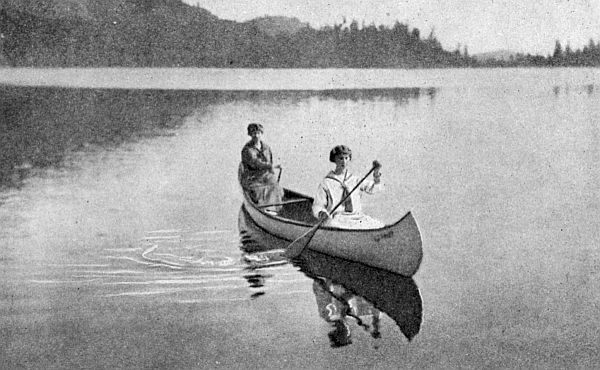


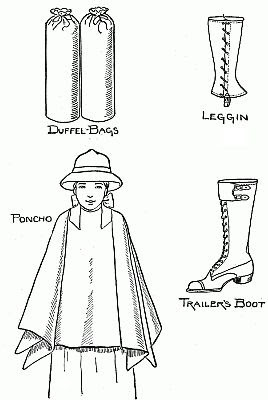
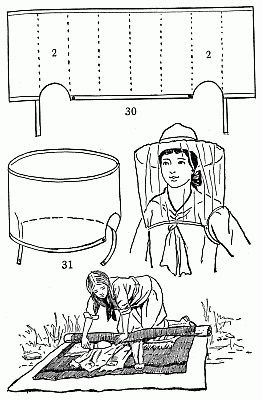
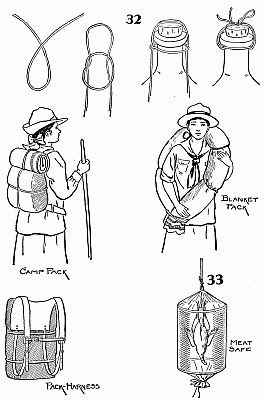
A girl had to be careful stalking a bird:
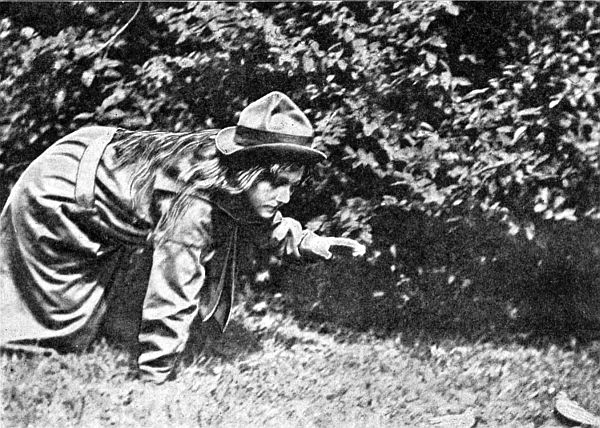
But not when frolicking with bears:







A girl had to be careful stalking a bird:

But not when frolicking with bears:

Last edited:
- Joined
- Mar 20, 2013
- Messages
- 3,356
- Reaction score
- 484
For me I'm kind of coming back to "old school" ways. from september to june, we use a canvas wall tent. I'm going back to traditional wooden paddle design that I make, I certainly use an axe, a knife, I use a small bow saw. As for fishing, i'm not really good a it but like it and really enjoy fly fishing seems to be good at catching arctic grayling, and pikes... In terms of cooking and kitchen, we cook mainly on fire, but usually bring a Trangia. I like to use the dutch oven, and in the future, I would like to get a reflector oven. A large tarp, alway have one!! In regard to guns, I some time cary the old mosberg 12 gauge pump action for bears.... Never had to use it. When it is hunting season, I cary my ruler #1 international 30-06. On the wish list, is a few canvas canoe packs, a wood canvas canoe. I don't smoke, but bring a bit of Port or good Brandy for around the fire!!
Cheers
p.s. We do cary a good first aid/repair kit, a sat phone( the wife wants to) and since we do more of our travel on river with rapids, we have a pin kit/extraction kit, so pulleys, prussic loop, tubular webbing loops, binners, and of course good dynema rope throw bags.
Cheers
p.s. We do cary a good first aid/repair kit, a sat phone( the wife wants to) and since we do more of our travel on river with rapids, we have a pin kit/extraction kit, so pulleys, prussic loop, tubular webbing loops, binners, and of course good dynema rope throw bags.
Last edited:
Similar threads
- Replies
- 28
- Views
- 7K
- Replies
- 23
- Views
- 6K
- Replies
- 26
- Views
- 6K
